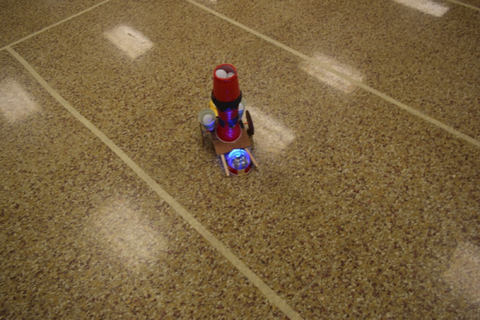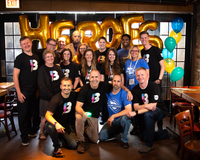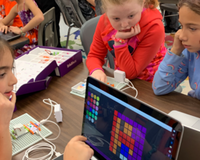From smart phones to self-driving cars, our world is filled with technology. But students and educators alike can still be intimidated about where to start with robotics. Here are four tips that helped me navigate the world of robotics as a student, and now as an educator!
1. Forget everything you think you know about robotics
When jumping into a totally brand-new subject like robotics or computer science, it is hard to know where to start. Growing up in the age of popular movies like Star Wars, Wall-E and Big Hero 6, I was always interested in robotics and thought it was cool, but never saw it as something that I could actually do myself. I thought it was a job for someone who only got straight A’s in school and had to sit in a cubicle isolated from the world all day long. And something boys did. These stereotypes caused me to not really give robotics a second thought until my junior year of college, where I was surprised to learn that robotics can actually be fun, engaging and team-oriented.
I studied mechanical engineering in school because let’s be honest- like every teenager entering college, I had no idea what I wanted to do. I thought mechanical engineering sounded interesting and was a field I knew I could find a job in. I struggled through boring math and science classes, but I finally found my passion for engineering when I was in a class that asked us to build and program our own battle bot from scratch. From previous programming classes I was very reluctant to do any coding, but I decided to keep an open mind and jumped in to help. To my surprise, I found that it was something I actually enjoyed. Programming a robot made computer science fun and understandable. If the robot went in the wrong direction or did the wrong thing, I knew where to look in the code to begin fixing it. Being successful in even the smallest task of making the robot move forward gave me so much confidence in a subject I always felt out of place in. I then went on to teach a summer robotics camp, complete my senior design project in robotics, and eventually led me to the career I have today.

I currently run an after-school Space Club program where I see 200 middle schoolers each week. Yes, 200 students that have already been in school for 8 hours and are tired of sitting still and listening. Yet somehow, I have to try to find a way to capture their attention and actually teach them something. Whenever I tell my students ‘We are going to spend the afternoon learning about computer science and programming’, they immediately stop listening and start rolling their eyes. To get them pumped, I bring out Sphero because it’s non-intimidating, fun and gets the kids excited about computer science. I encourage them to keep an open mind and just give it a chance. I tell students that robotics is not just for boys, it’s not just for smart or nerdy kids, and you can never be successful at something if you don’t even start. Once I bring out Sphero and do a quick demo, they are quickly sold. I let them drive it around, race each other, play hot potato… and by the next week they’re asking when we are going to be using the Sphero robots again. Sphero has completely changed how my students view robotics and computer science. From boring to fun, they realize robotics is something that students with any skill level is capable of doing. Also, since Sphero has no small parts or tedious building, it allows teachers like me to spend more time on the most important part- teaching important programming skills.

2. Think like an engineer
The confidence I gained from successfully programming my first robot is what I try to instill into my students. And I can do that because of Sphero. I’m passionate about showing my students that a STEM education is for everyone. It’s not just for the kids that get all A’s in class and breeze through standardized testing. STEM is also for kids that are curious about the world and the way it works. It’s not just about math and science but learning how to think like an engineer. By that, I mean learning how to solve a problem and thinking critically on how to fix or improve it. This skill is particularly useful for troubleshooting code to find out where the problem is. Problem solving and thinking critically are 21st century skills that students will use in any job they have in the future. The skills taught from robotics are needed by every student to succeed in today’s world.
3. Fail forward
I heard this phrase at a conference, and I am constantly repeating it to my students. And let’s be honest, sometimes even to myself! It’s ok if you don’t get things right the first time, especially when it comes to computer science. No one ever writes a piece of code and has it work perfectly the first time. So learn from your mistakes to help propel yourself forward to the next project.
Most teachers don’t do robotics because they’re intimidated and don’t know where to start. But, please do exactly that — just start. Don’t feel like you have to know everything before you begin. It’s ok to learn with your students. They might even be able to teach you a thing or two! Whenever planning out Sphero activities, I like using the steps of Play, Program, and Design. So start small with having the students drive the Sphero. You can even paint with the Sphero, make light shows, and then when comfortable, start branching out into block coding and design challenges.
4. Don’t be afraid to go #BeyondCode!
While kids of all ages love robots, you know who loves them even more? Parents. Yes, parents. Of all the family nights I have done in my program, the most successful ones have incorporated a Sphero design challenge. After the students have been working with Sphero for a few weeks, they are excited to invite their parents to the event and show off their new programming skills. It’s a great way to involve families and show them the importance of a STEM education and going to college. Past projects have included asking the students to build a chariot to carry a payload to the finish line or create a structure around the Sphero to pop a balloon. As a teacher, encourage your students to be creative when designing their new device, because creativity combined with science and engineering are the building blocks of the future.

I fell in love with robotics, and you will too. Don’t be intimidated. Start slow, and your students will surprise you. Robotics can even transform lives. I work in low-income schools, and our students struggle with problems beyond school. A student from this past year barely spoke English and did not talk or engage with other students. I did not know how to reach her, but she kept coming back every single week. When we gave her a Sphero, we were shocked that she was able to figure out how to code and program the robot through a maze all by herself! Her confidence grew, and she ended up going around helping all the other students finish their programs. She gained communication and leadership skills that she would not have normally gained if it wasn’t for Sphero.
I hope this motivates you to give robotics a try or get started using it in your classroom. For me, once I saw beyond the code, I saw robotics and computer science as the key to changing the world and molding the future.

Aspen Meineke is our Sphero Hero from Texas. She is your average 20-something year old, who is fueled by coffee and tacos. Avid country music and Harry Potter fan. Yes she does say y’all and no she does not ride a horse to work.










